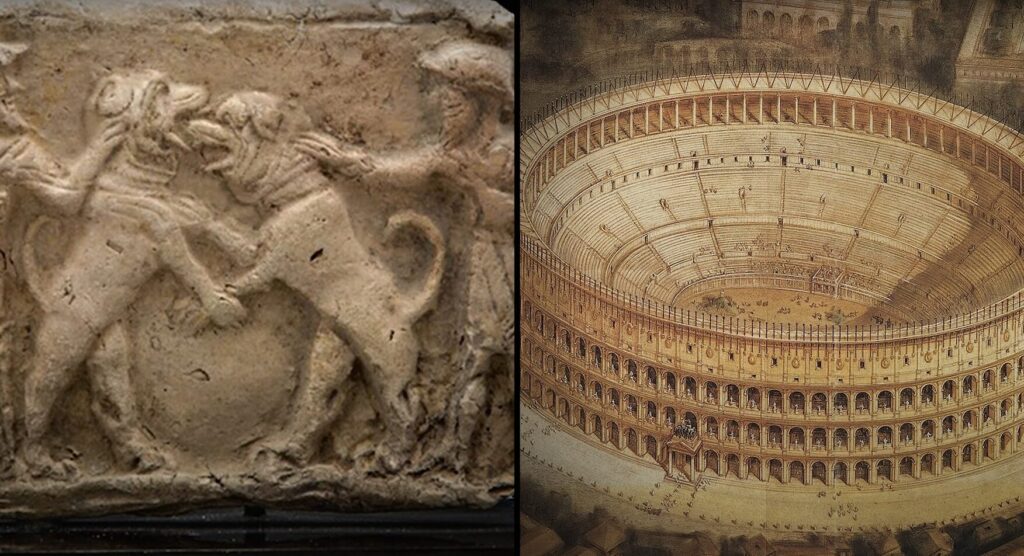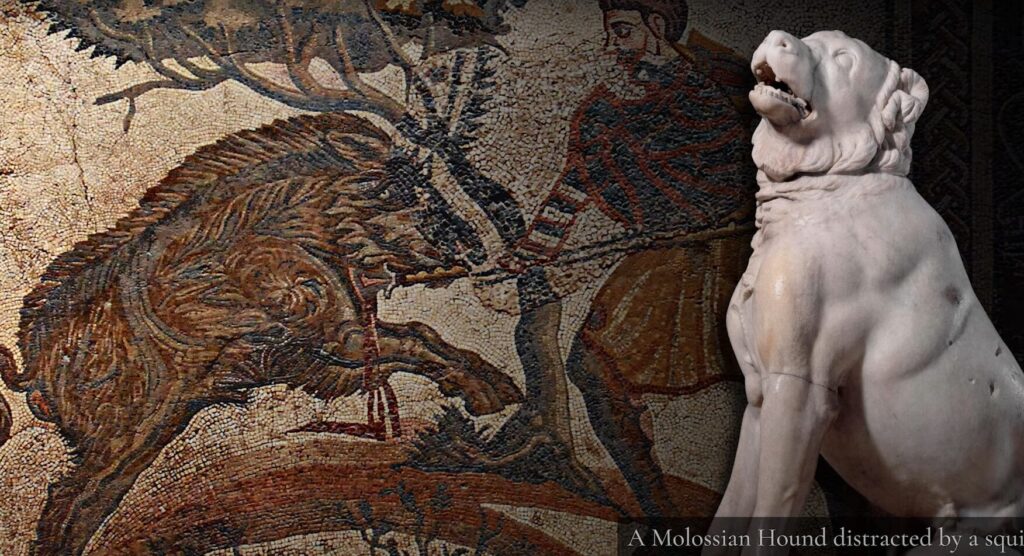Over thousands of years, people and dogs have shared a close relationship. Through selective breeding, humans have created many different types of dogs for work, companionship, and other purposes. In ancient times, especially in Rome, dogs came in many varieties, from large guard dogs to small pets that lived with wealthy families.
The way people thought about dogs in the past was different from today. There were no official breed standards, and a dog’s job was often more important than its appearance. Even so, some early types of dogs, or proto-breeds, became more common and important in history, showing the strong bond between people and their canine companions.
Key Takeaways
- Dogs have been closely connected to people for thousands of years.
- Early dog types often depended on their roles rather than strict breed standards.
- Ancient societies valued dogs for many different purposes and created many unique varieties.
Origins Of Dog Domestication
Dogs were the first animals that people domesticated. Over thousands of years, people bred them for different looks and behaviors. This led to many types of dogs, from big ones to tiny ones.
Archaeologists studying ancient sites have found evidence of lots of different dog sizes and shapes. At Vindolanda in northern England, bones show dogs ranging from very small, like miniature poodles, to very large, like great pyrenees. Even Roman dog paw prints on clay roof tiles give clues: some are small and delicate, others are big and deep.
Key Points About Early Dog Types:
- No official breeds existed in ancient times.
- Dogs were used as sheepdogs, guard dogs, hunters, or pets.
- Wealthy Greeks and Romans were picky about which dogs they kept, so a few special types (sometimes called proto-breeds) appeared.
- Physical appearance was less important than what the dog could do.
Some Proto-Breeds of the Roman World:
| Name | Description | Main Uses |
|---|---|---|
| Malasian Hound | Large, deep-chested mastiff with rough neck fur | Hunting, guarding |
| Laconian Hound | Slim, fast hound | Chasing deer, hares |
| Vertragus | Very slim, swift, like a greyhound | Hunting, pets |
| Maltese Dog | Small, fluffy, easily carried | Companionship |
Most of these ancient dog types do not match up directly with any modern breed. Still, the variety shows that even 2,000 years ago, dogs already came in all shapes and sizes, filling many different roles for people.
Selective Breeding And Evolution Of Dog Varieties
Selective breeding has shaped dog varieties for thousands of years, long before strict breed standards existed. Over many generations, people chose dogs for certain traits like size, behavior, and work ability. This practice led to a wide range of dogs suited for specific jobs.
During the Roman era, dog types varied greatly. Archaeologists have found paw prints and bones that show Roman dogs ranged from tiny lap dogs to huge mastiffs. These dogs served many roles, such as hunting, guarding, or being household companions.
Examples of Classical Dog Types:
| Variety | Description | Main Roles |
|---|---|---|
| Malasian Hound | Large, broad-muzzled, rugged-neck fur | Boar hunting, guarding, carts |
| Laconian Hound | Medium, slim, fast | Deer and hare hunting |
| Vertragus | Sleek, even faster, similar to greyhound | Hunting, pets |
| Maltese Dog | Small, fluffy, stubby legs | Lapdog, companion |
Unlike today, ancient people did not judge dogs by strict standards. Dogs were known for what they could do, not just how they looked. Some types became popular, like pet Maltese dogs carried by Roman women, or powerful Malasian hounds used by hunters and even in the arena.
Many other dog kinds existed in different regions, though most have no direct link to modern dog breeds. Still, these ancient varieties show how people have always valued dogs for their many shapes, sizes, and skills.
Dogs and Daily Life in Ancient Rome
What Archaeology Shows Us

Archaeologists have uncovered paw prints left in ancient Roman roof tiles. These impressions vary widely. Some are tiny, likely made by small lap dogs. Others are deep and wide, showing the size of much larger animals.
Excavations at places like Vindolanda in northern England revealed dog bones of many sizes. Researchers found remains from tiny dogs about as small as miniature poodles to those the size of great Pyrenees. This wide range highlights that Roman dogs were quite diverse.
Common Jobs and Everyday Use
Romans did not care much about a dog’s looks. Instead, they focused on what the dog could do. Most dogs served a purpose, such as herding sheep, guarding homes, or hunting. The idea of official dog breeds did not exist. Their roles and size matters more than appearance.
Well-known types included:
- Large Mastiffs: Used for hunting boars, guarding, and even pulling carts. Some emperors used them to pull chariots.
- Slim Hounds: The Laconian and Vertragus were hunting dogs, chasing deer and hares.
- Small Companions: Maltese dogs were popular with wealthy Romans. They were carried by ladies and sometimes buried with their owners.
Roman dogs had many uses, from work to being cherished pets. There were even special graves for beloved lap dogs. Most regions had their own local types, showing just how important and varied dogs were in Roman daily life.
Defining Dog Breed Standards
In the past 150 years, the idea of having strict standards for dog breeds became the norm. This change happened after kennel clubs were created and pedigree registries began. Before this, dogs were usually identified by what job they did—such as sheepdog or guard dog—rather than how they looked.
Key differences between ancient and modern approaches:
| Era | How Dogs Were Classified | Appearance Important? |
|---|---|---|
| Classical | By purpose or job | Rarely |
| Past 150 years | By specific breed standards | Very much so |
In ancient Greece and Rome, only a few special types, or “protobreeds,” were recognized for their looks and abilities. Most dogs were valued for their skills, not for having a certain shape or size.
With the rise of organized breeding, clear rules now exist. These standards describe the look, behavior, and ability expected for each breed. Today, official breed standards guide which dogs can be registered or shown at dog shows. This system shapes the way people breed and choose dogs worldwide.
Early Dog Types of the Ancient World
Giant Molossian Mastiffs
The largest dogs from the classical world were big, strong Molossian mastiffs. These dogs had wide chests, strong jaws, and a thick mane of fur around their necks. Molossians were used for hunting big animals like boars and could chase down dangerous prey.
Rich families used Molossians for protection, and some even used them to pull carts. There is a story of an emperor who tied four of these dogs to a chariot and rode around his estate. They also appeared in arenas, chasing wild animals or guarding homes.
| Feature | Description |
|---|---|
| Size | Large, powerful |
| Main Role | Hunting, guarding |
| Appearance | Muscular, thick neck |
Swift Spartan Hound
Medium-sized and fast, the Spartan hound was famous for chasing deer and rabbits. This variety was slim and built for speed, making it perfect for long hunts. Over time, it became less common, replaced by even faster dogs.
These hounds were valued by hunters for their energy and ability to keep up with quick prey. Their slim build made them stand out from other types.
Ancient Greyhound
Later on, the ancient greyhound appeared and became popular for its incredible speed. This slim dog is similar in looks and shape to the modern greyhound.
Greyhounds were popular as both hunting dogs and pets. The historian Arrian had one that kept him company wherever he went, even while he wrote or exercised.
Key Facts:
- Very fast and slender
- Used for hunting as well as companionship
- Known for loyalty and intelligence
Small Maltese Companion
The smallest well-known type was the ancient Maltese. These tiny dogs had stubby legs and a fluffy coat. They were close in size and shape to a modern Pomeranian, making them easy to carry and very popular among the wealthy.
Roman ladies often carried their Maltese dogs with them, sometimes naming them cute names like “Smidgen” or “Pearl.” These dogs got a lot of attention, and some were even given tiny tombs and special headstones. Wealthy families treated them like members of the family.
Fun Facts:
- Small, fluffy, and easy to carry
- Treated as pets and symbols of status
- Sometimes buried beside their owners
The Role of Dogs in Roman Society and Culture
Dogs as Companions and Symbols of Status
In ancient Rome, dogs were found in many shapes and sizes. Wealthy families often kept small, fluffy dogs that could fit in a cloak or handbag. These little dogs were treated as prized pets. Roman ladies sometimes named them with terms of endearment and carried them everywhere.
Larger dogs were also common. They served as protectors, hunters, or even pulled carts. Some emperors reportedly used massive hounds to pull their personal chariots around their estates.
A few special types of dogs, like the Maltese, Laconian hound, and Malasian hound, became well known among Romans. These dogs reflected the owner’s taste, activity, and social status.
Examples of Dog Varieties
| Type | Size | Main Role | Description |
|---|---|---|---|
| Malasian Hound | Very large | Hunting, guarding | Muscular, broad-muzzled, thick neck fur |
| Laconian Hound | Medium | Hunting | Slim, fast, pursued deer and hares |
| Maltese | Small | Pet, companion | Fluffy, handbag-sized, adored by women |
Remembering Dogs: Burial and Memorials

Romans sometimes showed deep affection for their dogs after death. Some pet dogs were buried beside their owners or honored with miniature tombs. Sarcophagi made just for dogs have been found, showing that these pets were valued family members.
Inscriptions on a few of these tombs show that dogs were mourned and remembered by name. Owners even wrote poems for their lost companions and treated their pets’ remains with care, much like they would with human family members.
Examples of Commemoration:
- Miniature sarcophagus for a dog with heartfelt inscriptions
- Portraits commissioned to remember special pet dogs
- Burial next to human owners as a sign of respect and love
Legacy And Diversity Of Ancient Dogs
Humans began living with dogs thousands of years ago. Over time, they selected dogs for different jobs and personalities. This led to a huge variety of shapes and sizes.
Evidence from Roman times shows many types of dogs:
- Small dogs: Delicate tracks, similar to modern lap dogs.
- Large dogs: Heavy paw prints, like mastiffs.
Archaeologists at Vindolanda found bones of dogs that ranged from miniature poodles to great Pyrenees in size. Back then, dogs were categorized more by what they did than how they looked. For example, there were sheepdogs, guard dogs, and hunting dogs, but there were no strict breed rules.
Well-Known Ancient Dog Types
| Type | Description | Role |
|---|---|---|
| Malasian Hound | Big, deep-chested, had pointed ears and a ruff | Boar hunting, guarding |
| Laconian Hound | Slim and fast | Chasing deer and hares |
| Vertragus | Sleek and even faster, similar to a greyhound | Racing, pets |
| Maltese | Small, fluffy, easy to carry | Lap dogs, companions |
Some Romans spoiled their lap dogs, giving them names like Smidgen and Pearl and even commissioning portraits or special burials. There were many other regional varieties, often only found in one place.
Even though these ancient kinds of dogs do not match current breeds, it is clear that dogs have always been diverse. People have always valued them for many different reasons.
